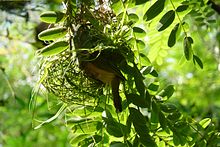Neck tape weaver
| Neck tape weaver | ||||||||||||
|---|---|---|---|---|---|---|---|---|---|---|---|---|

Neck tape weaver ( Ploceus castaneiceps ) |
||||||||||||
| Systematics | ||||||||||||
|
||||||||||||
| Scientific name | ||||||||||||
| Ploceus castaneiceps | ||||||||||||
| ( Sharpe , 1890) |
The neck tape weaver ( Ploceus castaneiceps , Syn. Hyphantornis castaneiceps ) belongs within the family of weaver birds (Ploceidae) to the genus of the bunting weaver ( Ploceus ).
The Latin additional species comes from the ancient Greek καστανον kastanon , German 'chestnut colored' and Latin ceps 'head, cap' .
The bird is found in East Africa , it is endemic in the border area between Kenya and Tanzania .
The range includes moist to swampy savannah as breeding area, drier habitats outside the breeding season, each from 250 to 1500 m. Height.
features
The species is 14 cm tall and weighs between 18 and 24 g. The male has orange-yellow on the forehead and most of the crown, an orange-maroon collar reaching from the back of the crown to a chest band of the same color, which sometimes looks more like a patch on the chest. The face looks yellow. The iris is dark brown, the beak black. The underside including the rump is yellow to light gray, the wing-coverts gray with yellow stripes and wing tips. The female has a greenish upper side with strong stripes, a clear yellow stripe above the eyes , the underside is light yellow, the beak is dark gray on the upper side and light gray on the lower side. Fledglings resemble the female but are more olive brown on top.
The species is monotypical .
voice
The male's singing is described as a deep chirping, "cree-er-curee-twee-twee", as simple, rough singing, soundless and harsh "chip chip".
Way of life
The diet consists mainly of seeds , but also insects . The species lives gregariously, foraging for food takes place in wooded areas, and breeds in swamps .
The nest is built by the male as a large oval nest hanging over the water on reeds or blades of grass. The clutch consists of 2 to 3 shiny, dark olive-green eggs.
The breeding season is between October and May in Kenya and September and January and April and May in Tanzania. The species is believed to be polygynous and breeds in colonies .
Hazardous situation
The stock is not considered to be at risk ( least concern ).
literature
- RB Sharpe in: Vol. XIII: Passeriformes. Catalog of Birds in the British Museum London: Trustees of the British Museum. Pp. 439, 448, plate 13, fig. 5
Web links
- Videos, photos and sound recordings on Ploceus castaneiceps in the Internet Bird Collection
- Weaver Watch
Individual evidence
- ↑ neck band Weber , in Avibase - The World Bird Database
- ^ JA Jobling: A Dictionary of Scientific Bird Names. Oxford University Press. 1991. ISBN 0-19-854634-3 .
- ↑ a b c d Handbook of the Birds of the World
- ↑ a b c d T. Stevenson, J. Fanshawe: Birds of East Africa. Kenya, Tanzania, Uganda, Rwanda, and Burundi. Princeton University Press, 2002, ISBN 978-0-691-12665-4 .
- ↑ Old World sparrows, snowfinches, weavers
- ↑ Redlist
